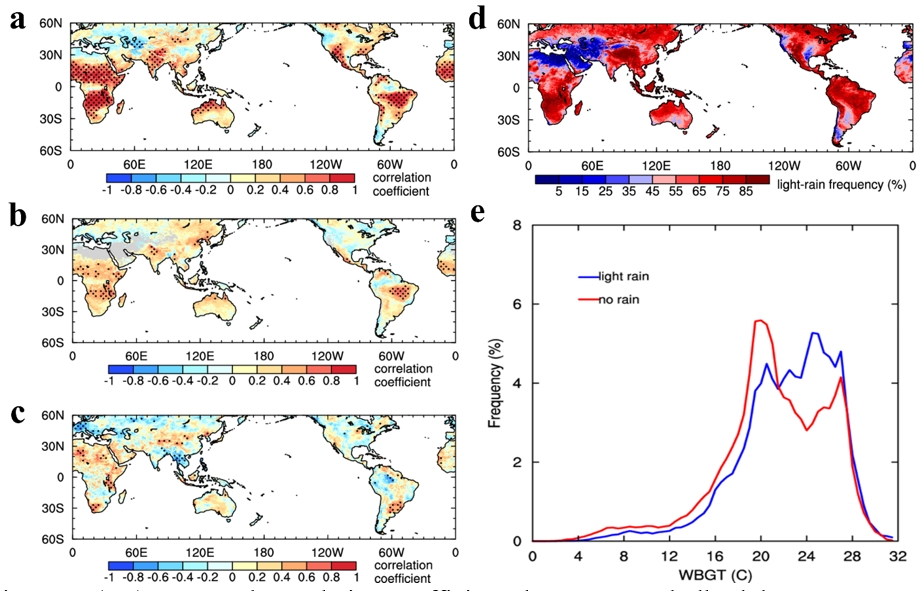Tsinghua Study Reveals Light Rain Intensifies Extreme Humid Heat
Humid heat waves pose significant risks to human health and the ecosystem. As climate warms, the intensity and frequency of future humid heat waves will further increase. When humid heat waves occur, the soil is wetter than normal, the planetary boundary layer is shallower, and surface evaporation increases near-surface atmospheric humidity. How do changes in related land-atmosphere processes on light rain days affect extreme humid heat? Currently, global climate models (GCMs) commonly suffer from excessive light rain. However, the impact of this bias on the simulation of humid heat waves remains unclear.
To address these issues, Associate Professor Yong Wang’s research group from the Department of Earth System Science at Tsinghua University, following their finding that light rain determines long-term aerosol wet deposition, further found that light rain exacerbates extreme humid heat by the enhancement of the total enthalpy flux and the shallowing of the planetary boundary layer. Based on their previous work of developing a stochastic convection scheme to reduce excessive light rain in GCMs, it is shown that with reduced light rain, the underestimations of humid heat waves in energy-limited regions and overestimations in water-limited regions are largely alleviated. This study, entitled Light Rain Exacerbates Extreme Humid Heat, has recently been published in Nature Communications.
It is found that the intensity of humid heat waves is significantly correlated with light rain frequency during the warm season, rather than with moderate-to-heavy rainfall or total precipitation. The probability of extreme humid heat days and the day before with light rain exceeds 50% worldwide except in arid regions like the Sahara Desert. The large-scale atmospheric states during humid heat waves with light rain and without rain are almost identical, but the former is more intense than the latter (Figure 1). This is because, compared with the case of no rain, although the surface downward shortwave radiation is reduced in the case of light rain, the increase of the total surface enthalpy flux and the decrease of planetary boundary layer height significantly enhance the extreme humid heat.

Figure 1. (a-c) Temporal correlation coefficients between wet bulb globe temperature (WBGT, heat stress index) and the frequency of light rain (a), moderate-to-heavy rainfall (b), and total precipitation (c). (d) Probability of extreme humid heat days and the day before with light rain. (e) Differences in the intensity of extreme humid heat between light rain and non-rainy cases.
Extreme humid heat with light rain lasts longer than rain-free extremes. However, intermittent light rain is more effective than consecutive light rain in prolonging the duration of humid heat waves (Figure 2). This is because light rain replenishes soil moisture, and to a certain extent, strong radiation maintains evaporation on subsequent rain-free days, providing water vapor stably for a longer period.

Figure 2. (a) Difference in the duration of consecutive events between light-rain and non-rainy cases. (b) Correlation coefficients between consecutive humid heat waves and light rain Gini index of light rain (indicating the distribution of light rain, the larger the index, the more uneven the distribution of light rain). (c-d) Days of consecutive events and rate of latent heat flux change as functions of Gini indices in the tropics (c) and mid-latitudes (d).
By reducing excessive light rain in the GCM, CAM5, increased evapotranspiration in energy-limited, low latitudes reduces the negative bias in the intensity of extreme humid heat, while decreased evapotranspiration in water-limited, mid-latitudes alleviates the positive bias in the intensity of extreme humid heat (Figure 3). These findings advance the understanding of the impact of reduced light rain on humid heat waves in a warming world.

Figure 3. After suppressing excessive light rain, the changes in (a) the Gini index of light rain and (b) WBGT during the warm season, and (c) their changes over corresponding evapotranspiration regimes (the closer the horizontal coordinate is to 1, the more evapotranspiration is constrained by water, and the closer the vertical coordinate is to 1, the more evapotranspiration is constrained by energy).
Zhanjie Zhang, a PhD candidate at the Department of Earth System Science, Tsinghua University, is the first author. The co-corresponding authors are Yong Wang, an associate professor at the Department of Earth System Science, Tsinghua University, and Guang J. Zhang, a professor at the Scripps Institution of Oceanography, University of California, San Diego. Co-authors include Cheng Xing, a special research assistant at the Aerospace Information Research Institute, Chinese Academy of Sciences, Wenwen Xia, a postdoctoral researcher at the Institute of Atmospheric Physics, Chinese Academy of Sciences, and Mengmiao Yang, an associate professor at the School of Geographical Sciences, Fujian Normal University. The research was supported by the Key Research and Development Projects of the Ministry of Science and Technology and the National Natural Science Foundation of China.

